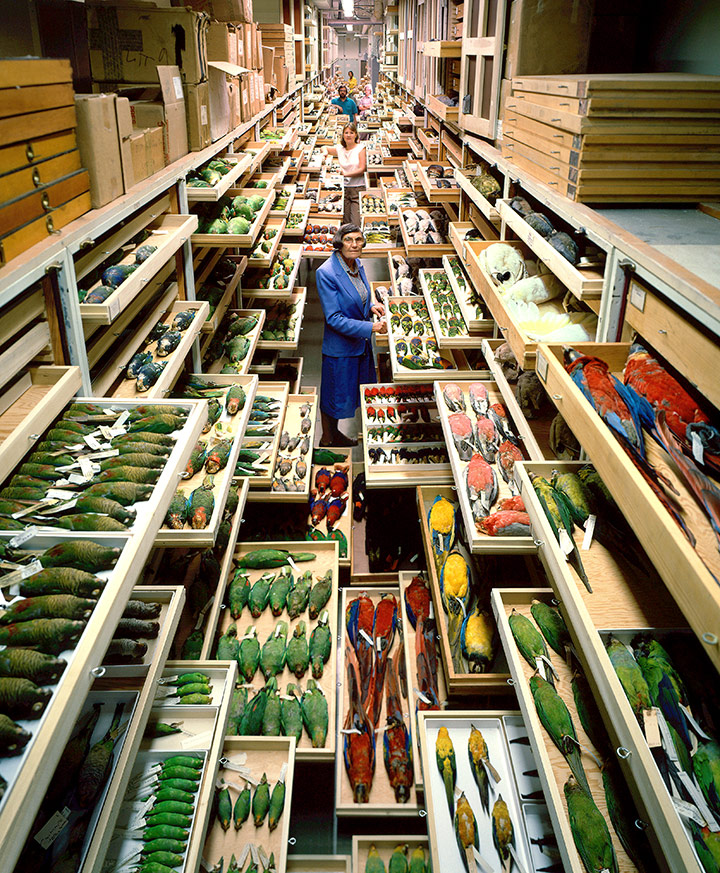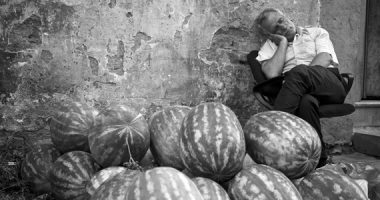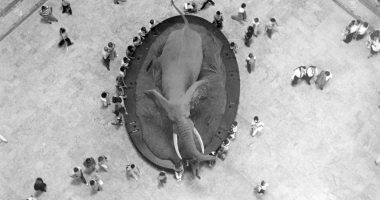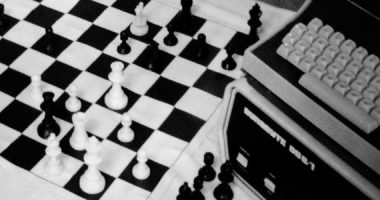
La experta en identificación de plumas Roxie Laybourne, rodeada de coloridas aves | Smithsonian Institution, National Museum of Natural History, Division of Birds. Fotografía de Chip Clark
Galleries, libraries, archives, and museums have traditionally been the institutions that have taken care of contents and made it possible to access them, although the way of doing so has gradually changed over the course of the years. At the dawn of the Internet era, the members of GLAM saw in the World Wide Web an opportunity for cheaply communicating the agenda of activities, saving it in the memory and making the recordings available to the public, thus putting an end to the institution’s physical and time limitations. Over a decade has passed and the Internet has become an infoxicated forest where all of us are fighting for the user’s attention. In the current context, the institutions are being transformed to promote the consultation of contents, progressing from the search function to the proactive invitation and converting the web into yet another of the museum’s halls.
The ten books that you absolutely must read, the best talks for understanding climate change, seven films for a rainy day, the songs most listed this month… The Internet is packed with lists. They are the symptom of a world that is super-populated with contents. Although the gateway to the Internet continues to be an (increasingly less neutral) search engine, the great contents platforms are structured based on selections. The constant competing for our attention and our free time has accentuated the need for different network actors to put contents in front of us. That proactive browsing of the beginnings has progressed into passive contemplation in front of one big showcase. And the fact is that the Internet has become so vast that it seems that we need someone else to make the choice for us. But who?
One of the major tasks undertaken by cultural institutions during recent years has been the digitalisation of their collections. The creation of these sizeable archives has been accompanied by search interfaces that enable users to consult contents. With the opening of the institutions online, a less expert audience that is less familiar with the collection has started to make use of these tools. This is a user profile that does not use the archive as a collection for research, but rather understands it as a source of knowledge and of learning, a permanent space for education, often linked to leisure time. And this is where the search engines have a weak point: how do we find what we don’t know we are looking for?
A key question for understanding how the digital collections of institutions have been designed is to ask them for their reference points. When cultural centres reach the Internet, at least from a theoretical point of view, they become strongly impregnated with the optimism of first-time cyberculture. In this way values such as horizontality, open data, participation, collective intelligence, non-authorship and Do-It-Yourself all acquire value. Meanwhile, in contrast, hierarchy and prescribing take on negative connotations. Therefore, navigational architectures are designed with the aim of being neutral tools, which permit personalisation and free surfing by users.
As pointed out by Mike Pepi, “we cannot search for data in a museum in the same way we look for it in a database”, but the digital buildings that have been built follow a database logic. Institutions of all kinds, once they have entered the digital world, have become archives. Ultimately, they have digitalised and classified their contents, but not the discourses and stories that gave meaning to them. Perhaps it is time, therefore, to follow the same path that museology took: progressing from an anonymous, neutral space brimming with works to a curatorial discourse according to which each object is selected and positioned with an intention. It is necessary to once more give value to the care of contents and, in order to do so, it is necessary to find the way of digitalizing the stories threaded through them, taking into account the fact that that the nature of the Internet is dispersed and fragmented.
This does not mean preventing users from finding their own way but a recommendation from an expert can be a good guide for them. However, it is important to know who it is and why they are recommending. A friend who discovers a new band for us, a contents platform that suggests similar contents that other users have liked, or a bookseller who recommends a work from the genre that we have asked for: each recommendation can have meaning in different contexts, but if it is not transparent in terms of sources and criteria and it does not maintain coherence, it loses value.
In fact, in our everyday working lives, we have access to different experts and advisers, and it is important not to assimilate recommendations into a single voice. In the same way that cultural centres have incorporated a diversity of views, so curatorship of their digital contents must be diverse: as much with regard to who as with regard to what and how. The combinations of voices, themes and formats are immense, and they not only better reflect the complexities of the world, but also enable them to reach audiences with different sensitivities or preferences.
When we talk about the variety of influencers, we are not only referring to diverse profiles that can do an own reading of the archive. We also have in mind other options, such as social curatorship, which enables us to establish relations collectively, valuing, and labelling contents, or creating and sharing personal lists. Or, even, using artificial intelligence to read and link materials in ways that perhaps we hadn’t imagined, as done by the Tate in its project Recognition, which searched for works in its vast collection similar to online news images.
The digital space gives us the possibility of numerous simultaneous architectures, in which one single piece of content can form part of infinite different collections. For this reason, it can be a good place to explore “unimagined” approaches to archive collections. The opportunity opens up, therefore, to re-read materials and link them in new ways that have no place in physical spaces. The only limit is the collection available to us. For some time now, the more classical and obvious classifications have been joined by others that are more creative. A good example of this would be the Filmin catalogue of films, where we can find over 500 groupings that go far beyond the classic film genres.
The format also has to be a variable which must be played with. Beyond producing groupings of contents, it is possible to make new creations that are based on the material available in order to re-signify it and present it to the public in different ways. An example of this re-signification would be Cachitos de hierro y cromo, a musical programme that remixes fragments from the historical TVE archive and uses irony to reach a younger audience.
And the fact is that it is also necessary to take into account who we are addressing. The discourse may be thought up by the institution, but it must bear in mind the user it is addressing, the person whom it is guiding through its immense collection. For this reason, it is necessary to find a balance between own identity and user interests, between influencing and personalisation. Thus, the guides and recommendations cannot eliminate freer and more neutral forms of search. The doubt is how to establish a dialogue with users in order to offer them more personalised service, as we would do in a consultation with a librarian. One option could be the personalised recommendations from TED, in which user feedback fine-tunes the proposals from artificial intelligence. Another, closer to human contact, is the creation of virtual communities around the collections, in the style of that of Medialab Prado.
Having reached this point, we may wonder about the limits of curatorship. Is it necessary to establish our own collection as a perimeter, or is it possible to go further and incorporate external contents into it? Projects such as Europeanna and Google Arts & Culture demonstrate he enormous possibilities for integrating, into a single archive, works from diverse origins. But the institutions themselves can also use materials from other origins, as do Walker Reader and ICA Daily, in order to conjure up richer and more complete discourses.
Beyond its collection, what gives values to an institution and configures its identity is its capacity to create discourses. This idea leads us to think of a model in which rather than contents, it is stories that are positioned at the centre. When these stories are not just a technique for rescuing an archive collection and increasing visits, but the reason for guiding the whole activity, the source of the resources that we use to create them ceases to be so significant. In this way, incorporating materials from third parties progresses from being an inconvenience to being a virtue.
Cultural institutions coexist online with other contents platforms (music, videos, series, books, podcasts, etc.) which face similar challenges, and with which they share users. With the resources available to them, they have to consider how they can stay afloat in this wild and fragmented ecosystem. Asking themselves about their own essence may be a good starting point for rediscovering what makes them so singular and substantial.






Leave a comment